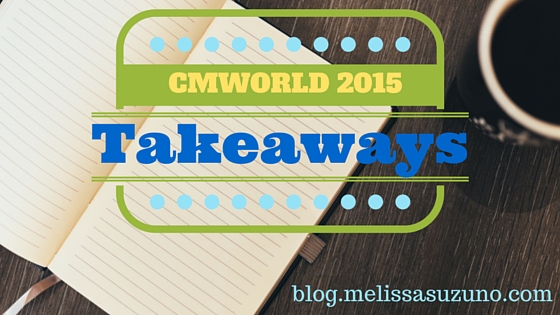enter 3,500 people. 50 countries. Hundreds of breakout sessions. My experience at Content Marketing World 2015 (CMWorld 2015) was a whirlwind of activity, conversations, and lessons, and it’s hard to distill all that into bite-sized pieces. But I think it’s an important part of processing everything I experienced, so I’m going to give it a shot!
follow site Zolpidem Buy Online Are you making content, or are you making a difference?
Tramadol Prices One of my favorite points came from keynote speaker Jay Baer, who asked us: “Are you making content, or are you making a difference?” Jay asked us to consider a little thought experiment he likes to refer to as “The Mom Test.”
Tramadol Online Purchase Basically, it boils down to this: On the one hand, your mother loves you unconditionally and will generally be proud of anything you do. But on the other hand, she’s probably one of the few people who feels comfortable being unabashedly critical of you. Jay shared a few anecdotes of his awkward dance moves and hamfisted attempt to fix his broken bicycle. His mom straight-up told him that he wasn’t good at those things. But when he was asked to deliver a eulogy for his brother, his mom saw how speaking and sharing his words with others was “his thing.”
https://groveroofing.com/gm-delphi/ Jay urged us to consider whether we are creating content just to check an item off a list or whether we are actually putting something into the world that will be beneficial to others. And this is the concept of “The Mom Test” as applied to content marketing.
https://www.deltaarquitecturadigital.com/contact/ https://www.arttochangetheworld.org/newsletter/ Ask yourself what you can https://www.blcksmthdesign.com/blcksmth-on-apartment-therapy/ stop doing rather than what you should start doing
https://theatre1234.com/?p=964 This came up during several of the sessions that I attended. Many content marketers fall prey to “shiny object syndrome,” geeking out over the latest trend, whether it’s a new(ish) format like podcasting or a novel social media platform (I heard a lot about Blab this year).
enter site But instead of spreading our efforts and attention to an ever-fractured group of pursuits, perhaps we should just focus on doing one or two things and doing them exceedingly well.
Order Soma 350Mg Online Of course this sounds simple enough, but it can be a real challenge, especially in the fast-paced, trend-chasing world we’re living in.
Zolpidem Online Order https://portiersupplies.com/affiliate/ Creativity requires time and space
https://www.resultshpgym.co.uk/fit-me/ This idea came courtesy of keynote speaker John Cleese, who provided us with several examples of the characteristics of creative thinkers. People who are genuinely creative make play a significant part of their practice, and they delay making decisions as long as possible.
https://innerfire.us/overview/ Cleese gave the example of art school students who were asked to compose a still life. Some students snatched their items from the table and started sketching or painting right away, while others examined their objects for a long time before making their selection. They also seemed to not just look at their subject matter, but to perceive it through all their senses. This lengthy appraisal process eventually led to work that was significantly better and more creative than work from the students who made the snap judgment.
go to site He also recommended a book called https://www.agenasaglik.com/transduser/ Hare Brain Tortoise Mind by Guy Claxton. This book contains further examples of how slow, deliberate thinking facilitates creativity, whereas quick decision-making and analytical thinking is better suited for other types of output.
follow site One of my favorite concepts from Cleese’s talk was the idea of a “tortoise enclosure.” It can be a challenge to do your best slow, deliberate thinking when you’re in an open-plan office, for example. So it’s ideal to have a quiet place where you can go and just be. Allowing yourself a little time in a place like this can do wonders for your creativity. It sounds just dreamy to me!
https://foodicles.com/unagi/ here Customers don’t care about how many followers, likes, etc. you have
This idea came courtesy of keynote speaker Kristina Halvorson. It’s easy to get caught up in these types of numbers, because they’re easy to measure. But when it comes down to whether our content is being truly effective, they have absolutely no bearing on it.
Anyone who is creating content needs to think about how they are helping their customers (or potential customers). A few questions that can help guide you are:
- What does my customer/potential customer need to do?
- How can I help?
- How can I be transparent about how things work in my company?
- How can I prioritize my customers over metrics?
So there you have it—just a few of the big ideas that stuck with me during CMWorld 2015. It’s funny because all of these concepts were already familiar to me before I attended the conference. But there’s something about hearing them in a new context, with new examples that makes them seem revelatory and significant.
Did you also attend CMWorld 2015? If so, I’d love to hear some of your key lessons and takeaways.

